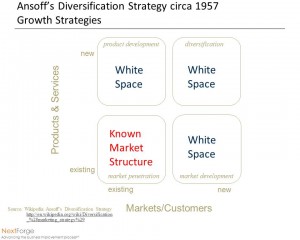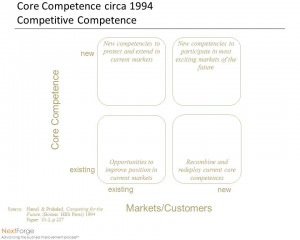 Blue Ocean Growth is not strategy
Blue Ocean Growth is not strategy
Strategy is based in competition, derived from Greek generals, and littered with the vocabulary of war. Our own definition of strategy, included within the strategic architecture of our strategy-paksm, builds off this combative thinking. And, while business strategy may share similar goals, tools and a development approach by the same accountable executives, let’s explore how Blue Ocean Growth- highly profitable growth- should be treated differently.
Blue Ocean Growth relies on marketing in one of its purest forms- marketing insights- to align market opportunity with company offering. Paraphrasing from some of our previous work Marketing Insights seeks, anticipates and understands customer needs, motivations, trends and behaviors. The blue ocean segment of the market is uncontested market space where competition is irrelevant, demand is created, and the market space is unknown1.
To complete the metaphor, the red ocean is known market space where products and services are prone to commoditization and where “evermore intense competition turns the water bloody”1.
Blue Ocean versus Red Ocean
| Red Ocean Strategy | Blue Ocean Strategy |
| Compete in existing marketplace | Create uncontested market space |
| Beat the competition | Market where the competition is irrelevant |
| Exploit existing demand | Create and capture new demand |
| Make the value/cost tradeoff | Break the value/cost tradeoff |
This table is excerpted from “Blue Ocean Strategy”, Harvard Business Review, October 2004
Kim and Mauborgne, the authors of “Blue Ocean Strategy” (2004), also layout the Four Actions Framework, a formalized analysis framework, to further differentiate red-ocean from blue-ocean (new value curve) markets.
- REDUCE: Which factors should be reduced well below the industry’s standard?
- CREATE: Which factors should be created that the industry has never offered?
- RAISE: Which factors should be raised well above the industry’s standard?
- ELIMINATE: Which of the factors that the industry takes for granted should be eliminated?2
Kim and Mauborgne have also substantiated the advantages of Blue Ocean Growth through their research of the lower percentage new market initiatives. Summarily, while blue ocean initiatives accounted for just 14% of the investment by the studied organizations, the blue ocean initiatives yielded 38% of all revenue growth and accounted for 61% of total profit.1
Blue Ocean Growth: A Historical Perspective
 Working with leadership teams over time, I have come to realize it can be helpful to go back to a version of Ansoff’s product/market matrix as a way to visualize the opportunities of blue ocean growth.
Working with leadership teams over time, I have come to realize it can be helpful to go back to a version of Ansoff’s product/market matrix as a way to visualize the opportunities of blue ocean growth.
- Product Development
- Market Development
- Diversification
- Market Penetration3 (Red Ocean)
 Fast forward about 40 years and consider Hamel and Prahalad’s seminal work Competing for the Future (1994). While discussing the capabilities (core competences) required to go to market, the concept of white-space with “mega-opportunities”4 assigned to what corresponds to Ansoff’s “Diversification” strategy along with the existing / existing markets’ analysis seems uncannily familiar.
Fast forward about 40 years and consider Hamel and Prahalad’s seminal work Competing for the Future (1994). While discussing the capabilities (core competences) required to go to market, the concept of white-space with “mega-opportunities”4 assigned to what corresponds to Ansoff’s “Diversification” strategy along with the existing / existing markets’ analysis seems uncannily familiar.
 Now skip another 10 years along the timeline to Kim and Mouborgne’s effort “Blue Ocean Strategy” (2004). And think back to our overview above. The same Ansoff/Hamel framework appears to be a natural fit. Bending the boundaries of known market space/industry, the adjacent opportunities resonate like Ansoff’s “market and product development” quadrants, and, when combined support the “diversification” cell. Further, looking through Hamel’s lens of capabilities helps us triangulate on red-ocean market penetration and utilizing existing capabilities beyond the boundaries of our known market.
Now skip another 10 years along the timeline to Kim and Mouborgne’s effort “Blue Ocean Strategy” (2004). And think back to our overview above. The same Ansoff/Hamel framework appears to be a natural fit. Bending the boundaries of known market space/industry, the adjacent opportunities resonate like Ansoff’s “market and product development” quadrants, and, when combined support the “diversification” cell. Further, looking through Hamel’s lens of capabilities helps us triangulate on red-ocean market penetration and utilizing existing capabilities beyond the boundaries of our known market.
 Blue Ocean Growth has a role in business planning
Blue Ocean Growth has a role in business planning
As you work through your business plans, talking about competitive strategy and Porter’s choice5, dedicate some thinking time for the unknown market spaces which provide a higher return than the blood red ocean of today’s marketplace.
End Notes and References
1 Kim and Mauborgne, “Blue Ocean Strategy”, Harvard Business Review, (October 2004)
2 Kim and Mauborgne, “Blue Ocean Strategy: From Theory to Practice”, California Management Review, (Spring 2005)
3 Ansoff reference from “Diversification (marketing strategy)”, Wikipedia [Internet] [Cited July 10, 2013]. Available from http://en.wikipedia.org/wiki/Diversification_%28marketing_strategy%29. Ansoff defined four main growth strategies in a market/product 2×2 matrix. Also see- Moore, Writers on strategy and strategic management, (New York, New York: Penguin 1992), pp 15-33.
4 Hamel and Prahalad, Competing for the Future, (Boston, MA: Harvard Business School Press, 1994). See Figure 10-2 “Establishing the core competence agenda”, p 227.
5 Porter, “What is strategy?”, Harvard Business Review, (November-December 1996)
First photo of girl and red ocean is from the internet. See http://www.izi-travel.com/the-blood-red-ocean-in-australia/








One Response